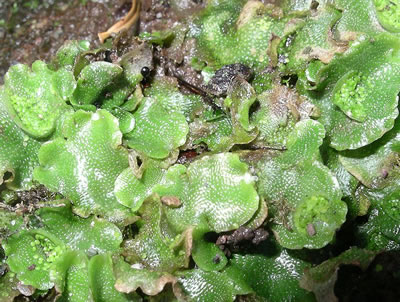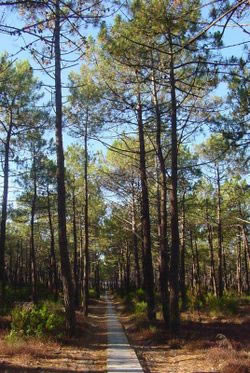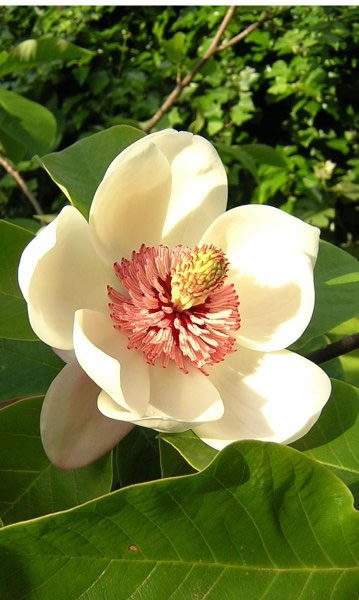Life on Earth originated in the oceans. Plants, like animals, evolved through a number of stages which enabled them to live and reproduce successfully on land.
Algae
Around 420 million years ago, some marine algae developed the ability to live outside the water by growing waxy cuticles that kept them from drying out. However, the algae that had these cuticles still needed to enter the ocean in order to reproduce sexually.
Algae reproduce both asexually, by division, as well as asexually. Sexual reproduction - and the genetic variation that it brings - is necessary for evolution to occur.
 Mosses and Liverworts
Mosses and Liverworts
Mosses and liverworts were the first plants to use the wind to assist in reproduction.
These plants alternate between sexual reproduction and asexual reproduction with each generation.
During sexual reproduction, the egg is attached to a stem. Sperm cells are released in the water and swim to the egg in order to fertilize it. The egg that is fertilized remains attached to the parent plant.
The next generation reproduces asexually. The plants of this generation consist of a thin stem with a hollow capsule in which many small spores are produced. When the atmosphere dries up, the wall of the capsule breaks and the spores are distributed by the wind. Those that land on a suitable site grow to become new plants.
These plants cannot grow very high. They have soft cells that aren't strong enough to allow their stems to stand up straight
Plants with Upright Stems
Over 400 million years ago, the first plants that could stand up appeared on Earth. These plants, which could grow to heights up to a few centimeters, had long cells with thick walls that allowed water to travel up a stem.
They had a horizontal stem that lay along or just below the ground. The upright stem was an extension of the horizontal stem.
This meant that these plants could only survive in places where there was a constant supply of aboveground water.
The First Trees - With Roots and Leaves
Three groups of plants - ferns, clubmosses and horsetails - went on to develop roots. This allowed them to absorb water from underground sources.
These plants had strong, woody vessels in their stems. This allowed the water that the roots absorbed to be transported up the stems.
The evolution of rigid stems allowed plants to grow very tall.
Because green plants depend on sunlight for photosynthesis, there was intense competition to grow taller. If a plant isn't as tall as its neighbors, it will be blocked from receiving sunlight and may die.
As a result of this competition for height, these plants grew very tall and became the first trees.
The ferns, and some clubmosses and horsetails, developed leaves, which were designed to collect as much light as possible.
Like mosses and liverworts, these early trees alternated between sexual and asexual reproduction.
Because male cells had to swim through the water to reach the egg, the generation that produced sex cells had to remain close to the ground.
As trees, these plants reproduced asexually, producing spores.
The spores grew into a thin, filmy plant called a thallus.
The thallus was moist underneath and resembled a liverwort. Its sex cells were released from the moist underside. Once they were fertilized, they grew into a tall plant.
Survival was difficult for the thallus. It would die if it became too dry. The tall trees of the previous or next generation blocked its light. Animals could easily reach it and eat it.
Wind as an Aid in Sexual Reproduction
About 350 million years ago, some plants appeared in which the sexual generation grew in the tops of trees, rather than on the ground.
Cycads are one such group of plants.
They look like ferns.
Some cycads produce small spores that are distributed by the wind. These spores are known as pollen.
Others produce big spores that remain attached to the parent plant.
These plants develop conical structures that are similar to a thallus. Eggs develop in these structures.
When a pollen spore lands on one of these cones, it grows a long tube. This tube burrows down into the cone.
After several months, the remains of the pollen grain become a sperm cell that is so large it can be seen by the naked eye.
Finally, the sperm cell enters the bottom of the tube, where it finds a small drop of water.
The sperm cell, which moves using cilia, swims around in the water for a few days. Eventually, it fuses with the egg and fertilizes it.
 Seeds
Seeds
Conifers, which include cedars, firs and pines, eliminated the need for water to transport sex cells during sexual reproduction.
These plants have a reproductive strategy similar to cycads. However, unlike cycads, with conifers, the egg-bearing cones and pollens are produced in the same tree.
It takes an entire year for the pollen tube to reach the egg.
The sperm does not swim around in a drop of water. It fuses directly with the egg.
The fertilized egg develops in the cone for over a year. During this time, the cone becomes filled with food supplies and is wrapped in a waterproof coat.
More than a year later, the cone dries out and opens up. The fertilized eggs, which contain their own food supply, drop out.
These eggs are known as seeds.
Seeds can remain dormant for years. They begin to grow into plants as soon as moisture penetrates them.
Flowers
 So far, plants had relied on water and wind for reproduction.
So far, plants had relied on water and wind for reproduction.
Water is not always available.
Depending on wind can be very wasteful.
When spores, which are used in asexual reproduction, are distributed by the wind, they will only develop into plants if they land in a spot with precisely the right conditions.
A pollen grain, used in sexual reproduction, which is blown by the wind, will only develop into a plant if it lands on a female cone. This means that plants such as pines must produce enormous quantities of pollen, most of which never develops into a plant.
Insects and plants evolved together. Insects are much more efficient than wind for transporting pollen.
An insect can take a small amount of pollen and place it precisely where it is needed in order for the egg to be fertilized.
Flowers developed as a way of placing the male and female parts of a plant next to each other, making it easier for insects to move pollen from the male part to the female part.
The first flowers, which appeared about a hundred million years ago, grew on magnolias.
In magnolias, the eggs are clustered in the center of the flower. The eggs are protected by a green coat with a spike on the end. This is known as a stigma.
Many stamens, organs which produce pollen, are arranged around the eggs.
The pollen has to be placed on the stigma in order for the egg to be fertilized.
Around this entire structure, there are leaves that have been modified to be brightly colored in order to attract insects. These modified leaves are known as petals.
In magnolias, as in many other flowering plants, the eggs and pollen develop at different times. This prevents cross-fertilization - pollen fertilizing an egg from the same plant. With cross-fertilization, there is no genetic variation.
The stigma of a magnolia flower will accept pollen as soon as the flower opens. However, the stamens won't produce pollen until after the eggs have already been fertilized, with the help of insects, by pollen from other plants.
Some flowers developed attractive scents to attract insects.
Others developed nectar as an insect lure.
Later on, some plants evolved flowers that encourage pollination by birds and bats.
Flowers that are pollinated by birds do not have a scent, but are brightly colored.
Flowers that are pollinated by bats have a musty smell.